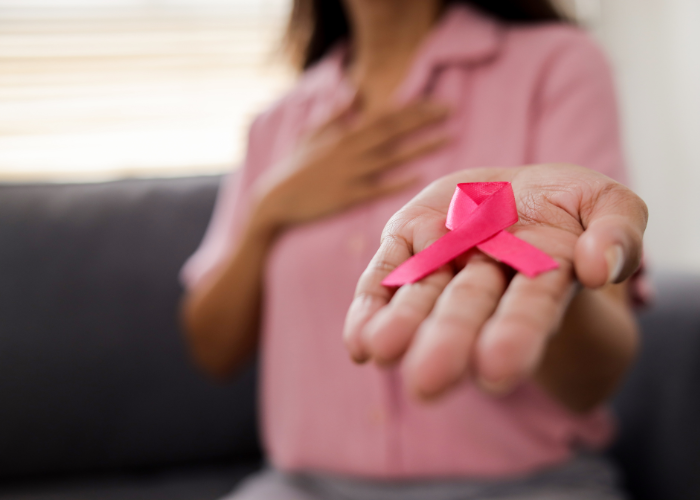IMANA NEWS
How to Prevent Breast Cancer
15 October 2025

Breast cancer is the second most commonly diagnosed type of cancer in the world, right after lung cancer.
And, 1 in 8 women worldwide will be diagnosed with the disease in their lifetime.
If that was not scary enough, there’s the fact that breast cancer does not wait for you to get older. Yes, the risks are higher for women who are 50 and older, but the reality is, you can get it at any age.
The good news is that if you detect it early, the five-year survival rate is about 90%.
This is why early detection is so crucial.
In this article, we take inspiration from October being Breast Cancer Awareness month and guide you through some actionable steps you can take to protect your health.
How to Understand if You are at Risk
Breast cancer can affect anyone. However, some of us may carry higher risks.
Recognizing your personal risk factors is a crucial step in how to prevent breast cancer.
The main factors that play a role include:
Your family history and genetics
If your mother, sister, daughter, or even any relatives on either side of your family have had breast cancer, your chances of getting it are higher.
This is where genetic testing plays an important role. Genetic testing can detect mutations in genes that are linked to breast cancer. These can include the BRCA1 and BRCA2, which can raise your risk to as much as 70%.
You can do genetic testing either through a blood or saliva sample.
It is important to remember that a positive result doesn’t mean you will definitely develop cancer. However, it gives you and your doctor to plan for more frequent screenings and even discuss preventive options.
Breast density
Dense breast tissue makes it harder to detect tumours on a mammogram and is itself considered a risk factor.
If you have dense breasts, your doctor may recommend additional imaging such as an ultrasound or an MRI, alongside regular mammograms.
Hormonal and Medical Factors
If you got your period early, or entered menstruation late, or even had children late in life, these factors can contribute to a higher lifetime risk.
If you have previously had breast cancer or certain non-cancerous breast conditions, you are more likely to face it again. Exposure to chest radiation (for example, during treatment for another condition in youth) is also a relevant factor.
Screening more often
If you fall into any of these higher-risk categories, your doctor may advise you to begin mammograms before the age of 40, repeat them more frequently, or combine them with other imaging techniques.
The goal is simple: to catch any signs of disease as early as possible, when treatment is most effective. To learn more about the importance of early detection, join our Cancer Screening Awareness webinar.
What to Do if You are at Risk
Discovering that you are at higher risk can feel daunting, but there are several proactive steps you can take.
The right path will depend on your unique situation, so it is essential that you consult with your healthcare provider.
Risk-reducing medications
Some doctors may suggest medicines that lower the risk by blocking how estrogen affects breast tissue. Tamoxifen is often prescribed before menopause, while raloxifene or aromatase inhibitors may be considered afterward.
These treatments aren’t suitable for everyone, but if you’re high-risk, it’s worth a conversation with your doctor.
Preventive surgery
For women facing a very high risk—such as those with a confirmed BRCA mutation—preventive surgery may be an option. This could involve a mastectomy or ovary removal, procedures that can cut risk dramatically, sometimes by as much as 90–95%.
However, these decisions are deeply personal, and genetic counsellors and specialists can help you understand both the benefits and the emotional weight involved.
Everyday Habits: How to Prevent Breast Cancer in Daily Life
You can’t control your age or family history, but you can make changes that lower your risk.
Maintain a healthy weight
After menopause, excess body fat can increase estrogen levels, which may fuel cancer growth. You should work towards achieving and maintaining a healthy weight.
Stay active
Movement helps regulate hormones and insulin, supports a healthy immune system, and keeps inflammation low.
Aim for at least 150 minutes of moderate activity, such as brisk walking, each week.
Limit alcohol
Alcohol increases the risk of breast cancer, and even one drink a day can raise that risk. If you drink, cut back where you can. Try alternating with alcohol-free days or swapping in sparkling water with fruit.
Eat well
So, can diet help prevent breast cancer?
Well, a healthy diet won’t prevent every cancer, but it can help reduce risk. Fill your plate with vegetables, fruits, whole grains, and legumes.
At the same time, go easy on processed meats, fried foods, and sugary snacks. In fact, plant-based diets have been linked to lower overall cancer risk. Plus, eating this way supports weight control, which is another risk factor.
Your October Takeaway
This Breast Cancer Awareness Month, don’t just wear pink, take action. Get a screening, build a healthy habit, or even talk to your family about their cancer story.
Breast cancer is a global challenge, but awareness, prevention, and early detection give us the power to change the story.
At IMANA, we believe in turning awareness into impact by providing healthcare, education, and outreach to communities in need. This October, we invite you to stand with us.
You can do this by making a small donation or simply sharing this message with others. Together, we can build healthier, stronger communities for the future.